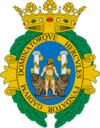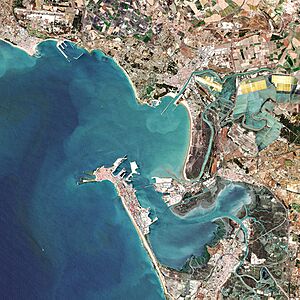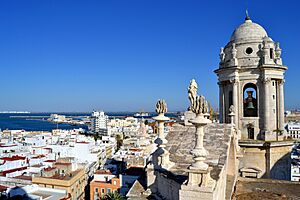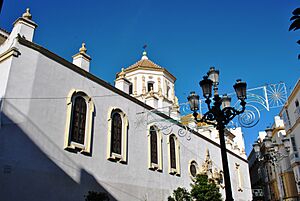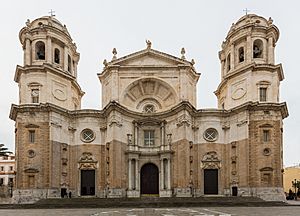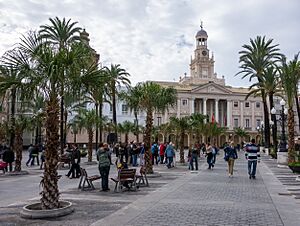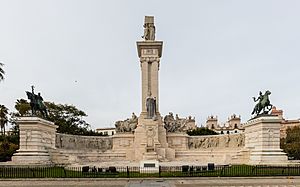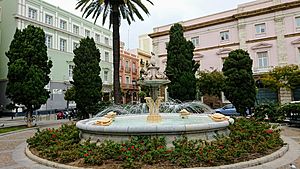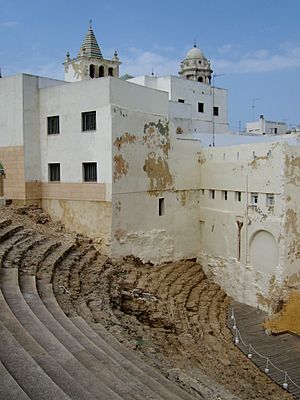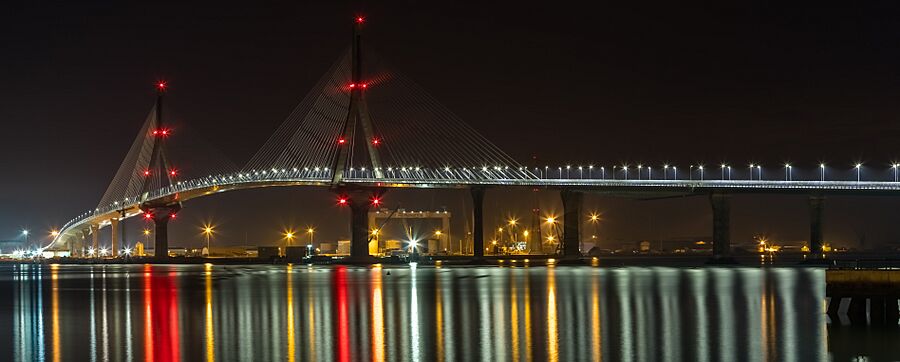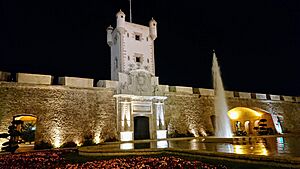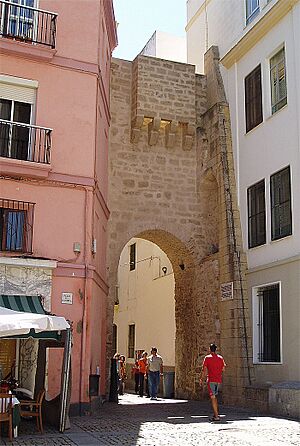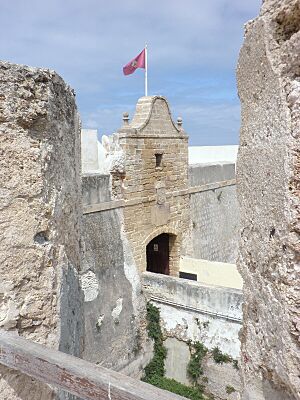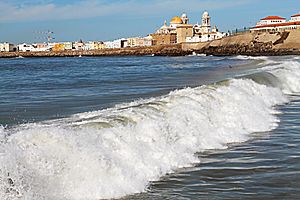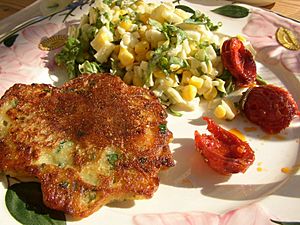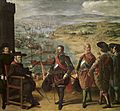Cádiz facts for kids
Quick facts for kids
Cádiz
|
|||
|---|---|---|---|
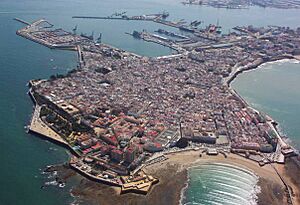
Aerial view
|
|||
|
|||
| Country | Spain | ||
| Region | Andalusia | ||
| Province | Cádiz | ||
| Founded | Phoenicians; traditionally claimed to be around 1100 BC | ||
| Government | |||
| • Type | Ayuntamiento | ||
| • Body | Ayuntamiento de Cádiz | ||
| Area | |||
| • Total | 12.10 km2 (4.67 sq mi) | ||
| Elevation | 11 m (36 ft) | ||
| Population
(2018)
|
|||
| • Total | 116,979 | ||
| • Density | 9,668/km2 (25,039/sq mi) | ||
| Demonyms | Gaditano (m), Gaditana (f) | ||
| Time zone | UTC+01:00 (CET) | ||
| • Summer (DST) | UTC+02:00 (CEST) | ||
| Postal code |
11001
|
||
| Dialing code | (+34) 956 | ||
Cádiz is a city in Spain. It is the capital of the Province of Cádiz in the Andalusia region. The city is located in the southwest of the Iberian Peninsula, right on the Atlantic Ocean. It sits on a narrow strip of land.
Cádiz is one of the oldest cities in Western Europe where people have lived without interruption. It was started by the Phoenicians a very long time ago as a place for trading. In the 1700s, the port in Cádiz Bay became the main port in Spain. It had almost complete control over trade with the Americas until 1778. Cádiz is also home to the University of Cádiz.
The city is mostly surrounded by the sea. Cádiz is a typical Andalusian city with many old and interesting buildings. The oldest part of Cádiz is called the Old Town. It has narrow, winding streets that connect to big open squares. The newer parts of the city have wide roads and modern buildings. You can find parks with exotic plants here, including huge trees brought from the Americas. One famous park is the historic Parque Genovés.
Contents
- What's in a Name? The Story of Cádiz's Name
- A Journey Through Time: The History of Cádiz
- Main Sights: Exploring Cádiz's Landmarks
- Famous People from Cádiz
- Climate: Sunny Cádiz
- Beaches: Fun in the Sun
- Culture: What Makes Cádiz Special
- Population: How Many People Live Here?
- Transportation: Getting Around Cádiz
- Sister Cities
- Images for kids
- See also
What's in a Name? The Story of Cádiz's Name
The Phoenicians, who first built Cádiz, called it Gadir or Agadir. This name meant 'wall' or 'stronghold'. Later, the Carthaginians used this name too.
When the Attic Greeks came, they called it Gádeira. The Romans knew the city as Gādēs. They even called their colony there Augusta Urbs Iulia Gaditana.
When the Muslims ruled, the Latin name changed to Qādis in Arabic. This is where the modern Spanish name, Cádiz, comes from. People from Cádiz are called gaditano (for a boy or man) or gaditana (for a girl or woman).
A Journey Through Time: The History of Cádiz
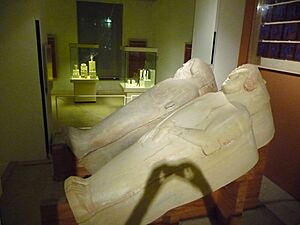
Early Days: Phoenicians and Trade
Cádiz was founded by the Phoenicians from Tyre. It is often called the oldest city in Western Europe that is still lived in today. The city was a very important trading center. It helped people get metals like gold, tin, and silver. The Phoenicians built a port here around 700 BC.
Even though people say Cádiz was founded around 1100 BC, the oldest things found by archaeologists are from the 9th century BC. This might mean that Gadir was a small trading post at first.
Carthaginian Empire and Roman Rule
The city became part of the Carthaginian Empire after the First Punic War. It was a key place for Hannibal when he was conquering southern Spain. He even made a sacrifice there before starting his famous journey to cross the Alps and invade Italy in 218 BC. Later, the city was taken by the Romans in 206 BC.
Under the Romans, the city was called Gades and became a busy port and naval base. Julius Caesar gave all its people Roman citizenship in 49 BC. Gades became a very rich city. It was known for its famous dancing girls, the puellae gaditanae.
Changing Hands: Visigoths and Moors
After the Roman Empire fell, the Visigoths took over in the 400s AD. Then, in 551, it was taken by the Byzantine Empire. It went back to the Visigothic Kingdom in 572.
From 711 to 1262, the city was under Moorish rule and was called Qādis. A famous story from this time tells of a giant "idol" that supposedly blocked the strait of Gibraltar. The Moors were finally driven out by Alphonso X of Castile in 1262.
Age of Exploration and Attacks
After 1492, Cádiz became very important. Christopher Columbus sailed from Cádiz on his second and fourth voyages. The city then became the main port for the Spanish treasure fleet, which carried riches from the Americas.
Because it was so important, Cádiz was often attacked by Spain's enemies.
- In 1587, the English sailor Francis Drake raided the harbor. He captured and destroyed many ships. This event was called 'The Singeing of the King of Spain's Beard'.
- In 1596, an English and Dutch fleet captured and looted the city. They burned much of it before leaving.
- There were other attacks in 1625 and 1702, but these were not successful.
A Golden Age and New Challenges
In the 1700s, the Spanish government moved its trade with the Americas from Seville to Cádiz. This was because the Guadalquivir River had too much sand, making it hard for big ships to pass. Cádiz then had a "golden age" and became one of Spain's biggest and most diverse cities. Many of the old buildings you see today are from this time.
However, in 1778, other Spanish ports were allowed to trade with the Americas. This ended Cádiz's special control over trade.
Napoleonic Wars and Revolutions
During the Napoleonic Wars, the British blocked Cádiz from 1797 to 1802 and again from 1803 to 1808. In the Peninsular War, Cádiz was one of the few Spanish cities that fought against the French. It became the place where Spain's government met. The important liberal Spanish Constitution of 1812 was created here.
In 1820, citizens revolted to bring back this constitution. Later, in 1868, another revolution in Cádiz led to Queen Isabella II leaving the throne.
Modern Times
In recent years, many old buildings and monuments in Cádiz have been cleaned and fixed up.
Main Sights: Exploring Cádiz's Landmarks
Cádiz has many interesting historical places. You can see a unique cathedral, an old theater, an old city hall, and an 18th-century watchtower. There are also parts of the old city wall and an ancient Roman theater. The old town has narrow streets that lead to beautiful squares, called plazas. Most of the famous buildings are in these plazas.
Plazas and Their Buildings
The old town of Cádiz is very crowded with narrow streets. But it also has several amazing plazas where people and tourists like to relax. Some of these are Plaza de Mina, Plaza San Antonio, Plaza de Candelaria, Plaza de San Juan de Dios, and Plaza de España.
Plaza de Mina
This plaza is in the middle of the old town. It was created in the early 1800s. Before that, it was an orchard for a convent. The Museum of Cádiz is located here. It has many items from Cádiz's 3000-year history and art by famous painters. The houses around the plaza were once home to rich families from Cádiz.
Plaza de San Francisco and San Francisco Church
This smaller square is next to Plaza de Mina. It has the San Francisco church and convent. The church was first built in 1566 and was updated in the 1600s.
Plaza San Antonio
In the 1800s, Plaza San Antonio was the main square in Cádiz. It is surrounded by large houses that belonged to the city's wealthy families. The San Antonio church, built in 1669, is also here.
On March 19, 1812, the Spanish Constitution of 1812 was announced in this plaza. Because of this, the plaza was first called Plaza de la Constitución.
Plaza de Candelaria
This plaza is named after the Candelaria convent, which used to be here. In the center of the plaza is a statue of Emilio Castelar, who was a president of Spain. A plaque on another house says that Bernardo O'Higgins, a hero from Chile, also lived here.
Plaza de la Catedral and the Cathedral
One of Cádiz's most famous sights is its cathedral. It's known as the "New Cathedral" and its official name is the Cathedral de "Santa Cruz sobre el mar". It was not built where the original cathedral was. The old cathedral burned down in an attack in 1596.
Work on the New Cathedral started in 1722. It took 116 years to build! Because it took so long, the design changed over time. It started as a Baroque style but ended up with a neoclassical look. Its chapels have many paintings and old items from other churches in Spain.
Plaza de San Juan de Dios and the Old Town Hall
This plaza was started in the 1400s on land taken from the sea. The Ayuntamiento (town hall) of Cádiz's Old City is here. The building was constructed in two parts, starting in 1799 and finishing in 1861. It mixes neoclassical and Isabelline Gothic styles.
Plaza de España and the 1812 Constitution Monument
Plaza de España is a large square near the port. The main feature here is the Monument to the Constitution of 1812. This monument celebrates the liberal constitution that was declared in Cádiz in 1812. The work on the monument began in 1912 and was finished in 1929.
Plaza Fragela and the Gran Teatro Falla
The original Gran Teatro (Grand Theater) was built in 1871 but was destroyed by fire in 1881. The current theater was built between 1884 and 1905. It has a unique red brick exterior in a Moorish revival style. After some changes in the 1920s, it was renamed the Gran Teatro Falla to honor the composer Manuel de Falla.
Other Interesting Sights
Tavira Tower
In the 1700s, Cádiz had over 160 towers where merchants could watch for ships coming from the Americas. The Torre Tavira was chosen as the official lookout tower in 1787 because it was the highest point in the city, 45 meters above sea level. It was named after its first watchman, Don Antonio Tavira.
Today, it is still the tallest tower in Cádiz. Since 1994, it has a camera obscura. This is a special room that uses a lens to project live, panoramic views of the Old City onto a round screen. It also has exhibition rooms and a rooftop terrace.
Admiral's House
The Casa del Almirante (Admiral's House) is a grand house built in 1690. It was paid for with money from the rich trade with the Americas. It belonged to the family of Don Diego de Barrios, who was an admiral of the Spanish treasure fleet. The outside is covered in beautiful red and white marble.
Old Customs House
Near the port of Cádiz, there are three similar buildings: the Customs House, the House of Hiring, and the consulate. The Customs House was built first, starting in 1765. It has a simple, classic design.
Palacio de Congresos
Cádiz's old tobacco factory has been updated to be a modern center for international conferences and trade shows.
Pylons of Cádiz
The Pylons of Cádiz are very unusual electricity pylons. They are on either side of the Bay of Cádiz and hold up huge electric cables. These pylons are 158 meters (518 feet) tall. They have a unique design with a narrow steel frame and a crossbar at the top.
Roman Theatre
The Roman theatre was found in 1980 in the El Pópulo area. It was discovered after a fire revealed old buildings, which were built on even older Roman stones.
This theater was built around 100 BC. It is the second-largest Roman theater in the world, only smaller than the one in Pompeii.
La Pepa Bridge
The La Pepa Bridge, also known as the Constitution of 1812 Bridge, opened in 2015. It crosses the Bay of Cádiz, connecting Cádiz to Puerto Real on the mainland. It is the longest bridge in Spain and one of the highest bridges in Europe, stretching 5 kilometers (3.1 miles). It is the third way to get into the city.
City Walls and Fortifications
Las Puertas de Tierra
Las Puertas de Tierra (Land Gates) were built in the 1500s. They were once part of several layers of city walls, but only one layer remains today. Now, two arches cut into the wall serve as a main entrance to the city.
El Arco de los Blancos
El Arco de los Blancos is a gate to the Populo district, built around 1300. It was the main gate to the medieval town.
El Arco de la Rosa
El Arco de la Rosa (Rose Arch) is a gate in the medieval walls next to the cathedral. It was renovated in 1973.
Baluarte de la Candelaria
The Baluarte de la Candelaria is a military fort. It was built in 1672 to protect the port of Cádiz. Today, it is used for cultural events and exhibitions.
Castle of San Sebastián
The Castle of San Sebastián is another military fort. It is located at the end of a road leading from Caleta beach and was built in 1706.
Castle of Santa Catalina
The Castle of Santa Catalina is also a military fort, built in 1598 after the English attacked Cádiz. It is at the end of Caleta beach. After being renovated, it is now used for exhibitions and concerts.
Famous People from Cádiz
Many notable people were born in Cádiz, including:
- Manuel de Falla (1876-1946), a famous composer.
- Chico Flores (born 1987), a professional football player.
- Lucius Cornelius Balbus, a Roman consul.
- Josefa Díaz Fernández (1871-1918), a flamenco dancer and singer.
Climate: Sunny Cádiz
Cádiz has a hot-summer Mediterranean climate. This means it has very mild winters and warm to hot summers. Because it's on a narrow peninsula, the sea greatly affects its weather. Cádiz has some of the warmest winters in Spain and Europe.
The city gets more than 3,000 hours of sunshine each year, making it one of the sunniest cities in Europe. Even though summer nights are warm, daytime temperatures are not as extreme as in inland areas. Snowfall is almost unheard of in Cádiz.
| Climate data for Cádiz (1991–2020 normals) | |||||||||||||
|---|---|---|---|---|---|---|---|---|---|---|---|---|---|
| Month | Jan | Feb | Mar | Apr | May | Jun | Jul | Aug | Sep | Oct | Nov | Dec | Year |
| Mean daily maximum °C (°F) | 16.2 (61.2) |
16.9 (62.4) |
18.7 (65.7) |
20.3 (68.5) |
22.9 (73.2) |
25.6 (78.1) |
27.7 (81.9) |
28.2 (82.8) |
26.1 (79.0) |
23.6 (74.5) |
19.6 (67.3) |
17.1 (62.8) |
21.9 (71.4) |
| Daily mean °C (°F) | 12.9 (55.2) |
13.7 (56.7) |
15.6 (60.1) |
17.2 (63.0) |
19.8 (67.6) |
22.7 (72.9) |
24.7 (76.5) |
25.3 (77.5) |
23.3 (73.9) |
20.6 (69.1) |
16.5 (61.7) |
14.0 (57.2) |
18.9 (66.0) |
| Mean daily minimum °C (°F) | 9.6 (49.3) |
10.5 (50.9) |
12.4 (54.3) |
14.2 (57.6) |
16.7 (62.1) |
19.8 (67.6) |
21.7 (71.1) |
22.4 (72.3) |
20.5 (68.9) |
17.6 (63.7) |
13.4 (56.1) |
10.9 (51.6) |
15.8 (60.4) |
| Average precipitation mm (inches) | 63.5 (2.50) |
51.6 (2.03) |
56.4 (2.22) |
42.9 (1.69) |
30.7 (1.21) |
6.6 (0.26) |
0.2 (0.01) |
1.8 (0.07) |
27.9 (1.10) |
73.6 (2.90) |
87.6 (3.45) |
79.5 (3.13) |
522.3 (20.56) |
| Average precipitation days (≥ 1.0 mm) | 6.5 | 5.7 | 6.4 | 5.3 | 3.4 | 0.7 | 0.1 | 0.3 | 2.6 | 5.9 | 7.1 | 7.2 | 51.2 |
| Average relative humidity (%) | 73.1 | 71.6 | 70.0 | 68.2 | 66.6 | 67.0 | 68.4 | 68.5 | 69.8 | 71.4 | 72.0 | 74.1 | 70.1 |
| Source: NOAA/NCEI | |||||||||||||
| Climate data for Cádiz (altitude 2m, 1981–2010 normals, extremes 1955–present) | |||||||||||||
|---|---|---|---|---|---|---|---|---|---|---|---|---|---|
| Month | Jan | Feb | Mar | Apr | May | Jun | Jul | Aug | Sep | Oct | Nov | Dec | Year |
| Record high °C (°F) | 24.1 (75.4) |
25.3 (77.5) |
29.0 (84.2) |
31.4 (88.5) |
36.5 (97.7) |
37.6 (99.7) |
40.0 (104.0) |
43.0 (109.4) |
37.8 (100.0) |
31.5 (88.7) |
27.6 (81.7) |
23.6 (74.5) |
43.0 (109.4) |
| Mean daily maximum °C (°F) | 16.0 (60.8) |
16.8 (62.2) |
18.8 (65.8) |
19.9 (67.8) |
22.1 (71.8) |
25.3 (77.5) |
27.7 (81.9) |
27.9 (82.2) |
26.3 (79.3) |
23.4 (74.1) |
19.6 (67.3) |
16.9 (62.4) |
21.6 (70.9) |
| Daily mean °C (°F) | 12.7 (54.9) |
13.8 (56.8) |
15.5 (59.9) |
16.8 (62.2) |
19.1 (66.4) |
22.4 (72.3) |
24.6 (76.3) |
25.0 (77.0) |
23.3 (73.9) |
20.3 (68.5) |
16.5 (61.7) |
13.9 (57.0) |
18.6 (65.5) |
| Mean daily minimum °C (°F) | 9.4 (48.9) |
10.7 (51.3) |
12.3 (54.1) |
13.7 (56.7) |
16.2 (61.2) |
19.5 (67.1) |
21.4 (70.5) |
22.0 (71.6) |
20.3 (68.5) |
17.3 (63.1) |
13.4 (56.1) |
10.9 (51.6) |
15.4 (59.7) |
| Record low °C (°F) | 0.2 (32.4) |
−1.0 (30.2) |
3.0 (37.4) |
6.5 (43.7) |
9.2 (48.6) |
11.0 (51.8) |
16.6 (61.9) |
15.6 (60.1) |
12.6 (54.7) |
8.0 (46.4) |
4.6 (40.3) |
1.5 (34.7) |
−1.0 (30.2) |
| Average precipitation mm (inches) | 69 (2.7) |
58 (2.3) |
35 (1.4) |
45 (1.8) |
27 (1.1) |
7 (0.3) |
trace | 2 (0.1) |
24 (0.9) |
67 (2.6) |
98 (3.9) |
92 (3.6) |
523 (20.6) |
| Average precipitation days (≥ 1.0 mm) | 6.9 | 6.4 | 4.8 | 5.6 | 3.2 | 0.9 | 0.1 | 0.2 | 2.5 | 5.6 | 7.2 | 8.1 | 50.7 |
| Average relative humidity (%) | 75 | 74 | 71 | 69 | 70 | 69 | 68 | 70 | 71 | 74 | 74 | 76 | 72 |
| Mean monthly sunshine hours | 184 | 197 | 228 | 255 | 307 | 331 | 354 | 335 | 252 | 228 | 187 | 166 | 3,024 |
| Source: Agencia Estatal de Meteorología (normals and extremes) | |||||||||||||
Beaches: Fun in the Sun
Cádiz is on a peninsula, so it has many beaches.
La Playa de la Caleta
This is the most popular beach in Cádiz. It is located in the Old City, between two castles, San Sebastian and Santa Catalina. It's about 400 meters (1,300 feet) long. La Caleta looks a lot like parts of Havana, Cuba. Because of this, it was used as a filming location for some scenes in the James Bond movie Die Another Day.
La Playa de la Victoria
This beach is in the newer part of Cádiz. It's very popular with both tourists and locals. It is about three kilometers (1.8 miles) long. There are many shops and restaurants along the avenue next to the beach.
La Playa de Santa María del Mar
This is a small beach between La Playa de Victoria and La Playa de la Caleta. It offers great views of the old part of Cádiz.
Culture: What Makes Cádiz Special
Carnival of Cádiz
The Carnival of Cádiz is one of the most famous carnivals in the world. All year long, there are activities related to the carnival.
The Carnival of Cádiz is known for its funny groups called chirigotas. These groups sing comical songs. A chirigota usually has seven to twelve performers who sing, act, and make up jokes. They play guitars, kazoos, and other instruments. There are also other groups like choruses, comparsas (who sing in harmony), cuartetos (four performers with funny skits and songs), and romanceros (storytellers who tell tales in verse). These shows turn the city into a colorful outdoor theater for two weeks in February.
There is a big contest called the Concurso Oficial de Agrupaciones Carnavalescas at the Gran Teatro Falla. Here, the chirigotas and other groups compete for prizes. This is the main event of the Cádiz carnival.
Food of Cádiz
The food in Cádiz includes many local stews and sweets. Some popular dishes are:
- Atún encebollado (Tuna with onions)
- Cazón en adobo (Marinated dogfish)
- Tortillitas de camarones (Shrimp fritters)
- Papas aliñás (Seasoned potatoes)
- Pan de Cádiz (A sweet bread)
Population: How Many People Live Here?
In 2021, the city of Cádiz had about 114,244 people. It is the third-largest city in its province. Cádiz is the only capital city in Spain that is not the most or second-most populated city in its province.
The population of Cádiz has been getting smaller in recent years. This is partly because the city is on a narrow strip of land surrounded by the sea. There isn't much space to build new homes. Many old buildings cannot be changed because they are historically important.
Also, it's expensive to build tall buildings in Cádiz because it's on a sandspit. This means the city's skyline hasn't changed much since the Middle Ages.
Cádiz also has a high rate of people who are looking for jobs. Many young people from Cádiz move to other parts of Spain or other countries to find work. The city has more older people than younger people.
Transportation: Getting Around Cádiz
Cádiz is connected to the European route E5. This road links it to Seville, Cordoba, and Madrid to the north, and Algeciras to the southeast.
The city is served by Jerez Airport, which is about 40 kilometers (25 miles) north. The airport has flights to Madrid and Barcelona, and also to the UK, Germany, and other European places. You can take a train from the airport to Cádiz's main train station.
The Cádiz railway station is just outside the old town. It has local, regional, and national train services. A high-speed train line to Madrid and Seville was finished in 2015.
The port across from the train station has weekly ferry services to the Canary Islands. It is also a stop for many cruise ships.
Sister Cities
Cádiz is connected with many cities around the world. These are called "twin towns" or "sister cities." They share culture and friendship. Some of Cádiz's sister cities include:
- Bogotá, Colombia
- Brest, France
- Buenos Aires, Argentina
- Havana, Cuba
- Mexico City, Mexico
- San Juan, Puerto Rico, USA
- Tangier, Morocco
- Veracruz, Mexico
Images for kids
-
Defense of Cádiz against the English, by Francisco de Zurbarán, 1634.
See also
 In Spanish: Cádiz para niños
In Spanish: Cádiz para niños



